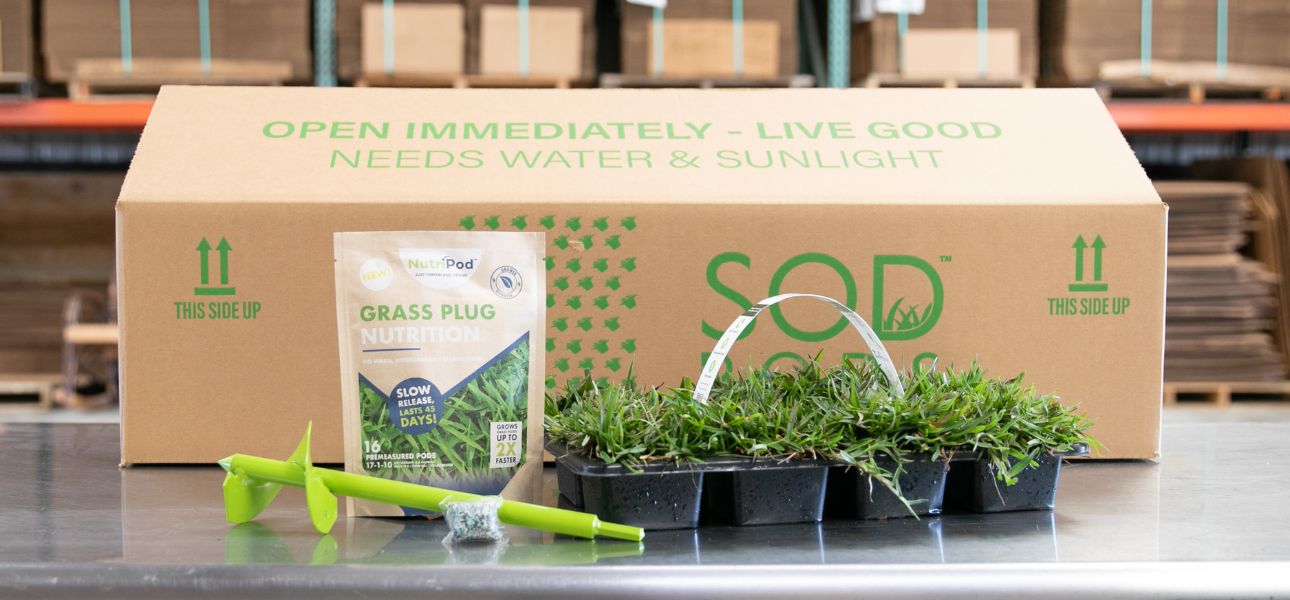How Deep Should You Dig for Grass Plugs?

A lush, green lawn doesn’t always require starting from scratch—sometimes, grass plugs are all you need to repair bare spots or establish healthy new growth. However, planting them correctly is essential to help them take root and spread efficiently. One of the most common mistakes homeowners make is not digging to the proper depth, leading to poor establishment, drying out, or slow growth.
Using the SodPods Power Planter makes the planting process faster and easier, ensuring your plugs are placed at the ideal depth with minimal effort. This specialized grass plug tool attaches to most cordless drills and creates perfectly sized holes for SodPods grass plugs. Whether you’re filling in patches or starting a new lawn, knowing how deep to dig and how to place the plugs correctly can make all the difference.
How Deep Should You Dig for Grass Plugs?
Planting grass plugs is a great way to fill bare spots or establish a new lawn, but proper planting depth is essential for success. Digging too shallow can expose roots to drying out, while planting too deep may slow down establishment. Using the SodPods Power Planter ensures precise hole depth, making it easier to plant SodPods grass plugs correctly. This specialized tool attaches to most cordless drills and creates a 3-inch-wide hole—perfect for the SodPods 3x3-inch plugs—promoting strong root contact and healthy growth.
By pairing the Power Planter with NutriPod fertilizer, which provides essential nutrients for up to 45 days, you can speed up plug establishment and lawn coverage. Proper aftercare, including consistent watering and good soil preparation, also plays a key role.

The Perfect Planting Tool: SodPods Power Planter
Planting grass plugs by hand can be time-consuming and physically demanding, especially if your soil is compacted. The SodPods Power Planter is designed to make the process effortless by attaching to most cordless drills, allowing you to dig consistent holes more conveniently.
With a 3-inch-wide auger and 12-inch length, it forms the perfect-sized hole for SodPods grass plugs, eliminating the guesswork in planting depth. Whether you’re filling in patches or planting across a large area, this tool ensures precise and even spacing, leading to faster lawn coverage. Plus, it makes the job enjoyable.
Power Planter Grass Plug Auger Key Features:
-
3-inch-wide auger—ideal for creating holes that perfectly fit SodPods grass plugs.
-
12-inch x 3-inch design—makes digging effortless, even in compacted soil.
-
Hand-welded, high-quality construction—ensures durability and long-term use.
-
Manufactured in the USA—built to last with an unconditional guarantee.
How to Properly Dig and Place Grass Plugs
Before planting, prepare your lawn by clearing debris, loosening compacted soil, and ensuring proper drainage. Using the SodPods Power Planter simplifies the digging process, making it easier to achieve uniform planting depth and spacing. Follow these steps for best results:
-
Drill a hole using the SodPods Power Planter. Ensure the hole is at least 3 inches deep to match the plug size.
-
Drop a NutriPod fertilizer into the hole. This slow-release fertilizer for grass has a 17-1-10 NPK ratio, providing essential nutrients for up to 45 days and helping plugs establish faster.
-
Insert the SodPods grass plug. Make sure it sits level with the surrounding soil to prevent drying out or slow growth.
-
Press the soil around the plug. This helps eliminate air pockets and ensures strong root contact for better establishment.
-
Water immediately. Keeping the soil consistently moist in the first few weeks promotes healthy root development, which is crucial during the establishment stage.

Additional Planting Tips
Spacing: Grass plug spacing depends on the type of grass and how quickly it spreads. Bermudagrass plugs, known for their aggressive growth and quick spreading, can be spaced on the wider end of the recommended 12–18-inch spacing. For slower-growing grasses like Zoysia, tighter spacing ensures a faster fill-in and minimizes bare spots. Closer spacing is especially important in high-traffic areas or when establishing a full lawn as quickly as possible.
Soil Preparation: Grass plugs are a homeowner-friendly option—they come as mature plants with an established root system, making them more resilient to various soil conditions. However, proper soil preparation can further improve their success rate. If the soil is compacted, aerate or loosen it before planting to facilitate root penetration and water absorption. Clearing out debris, such as rocks or thick thatch, also helps prevent obstacles that could slow root development.
Watering: New grass plugs require consistent moisture to encourage root establishment. Water daily for the first two weeks, keeping the soil evenly moist but not oversaturated. As you see new growth, gradually reduce the watering frequency to encourage deeper root development, which helps the grass become more drought-resistant.
Fertilization: Using NutriPod fertilizer pods at planting provides a balanced, slow-release nutrient supply to support early growth. With its 17-1-10 NPK formula, NutriPod boosts establishment and can accelerate growth by up to two times faster, giving your lawn a strong start while preventing the risk of over-fertilizing.
Final Thoughts
Digging the correct depth is essential for ensuring your SodPods grass plugs establish quickly and grow into a healthy lawn. The SodPods Power Planter simplifies the process by providing the perfect planting depth every time, making it an essential tool for homeowners looking for an easy and efficient way to plant grass plugs.
Want to see how easy it is? Check out our SodPods Planting Contest, where we put the Power Planter to the test! When paired with NutriPod fertilizer and proper aftercare, your new grass plugs will establish faster and fill your lawn beautifully. Happy planting!


